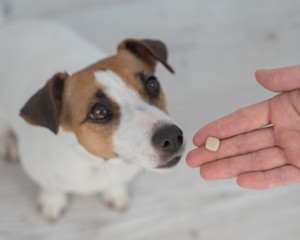Can I Give My Dog Piriteze?
The pollen is pollening

Share Article
In this article:
What is Piritezeopens in new tab Can dogs have Piriteze?opens in new tab Uses for Piritezeopens in new tab How Piriteze works in dogsopens in new tab Piriteze benefitsopens in new tab Piriteze side effectsopens in new tab Prescribing Piriteze to dogsopens in new tab
It’s likely many of us are familiar with the antihistamine Piriteze, especially if you suffer from the dreaded hay fever or have other allergies. But, have you ever wondered about antihistamine use in pets? Can it be used safely? What side effects might it have if you try to give it to your itchy, uncomfortable dog? Read on to find out more about Piriteze and whether it’s safe to use in your pet.
What is Piriteze?
Piriteze is a brand of antihistamine medication developed for humans and containing the active ingredient cetirizine hydrochloride. It usually comes in tablet form but there is also a liquid medication for children and it can be bought over the counter for humans.
Can dogs have Piriteze?
Yes, dogs can have Piriteze but it must be under veterinary guidance. As it is a human medication there is no licence for its use in dogs and so there is limited research into its effects. This means that dosage and potential side effects are not as well understood in dogs as they are in humans, so it is important to use this medication only with your vet’s say so and following their guidance.
This is extremely important as there are instances where giving your dog Piriteze is not advised. Additionally, the form in which it is given to dogs is very important due to some forms containing other ingredients such as decongestants, pain relief or sweeteners which could be toxic to your dog.
Common uses of Piriteze for dogs
Piriteze is an antihistamine which counters the effects of an allergic reaction. Dogs can have acute allergic reactions to bites and stings (just like us!) which will show up as a rash or red mark while environmental allergens such as grasses and pollen can cause sneezing, watery eyes or itchiness. Anaphylactic shock, while rare in dogs, can occur with symptoms of swelling around the face and throat which can potentially restrict breathing. More common are chronic allergies – for example allergies to certain foods (typically protein sources such as chicken). Chronic allergies generally affect the skin and paws with intense itchiness, chronic ear infections or anal gland issues that can occur due to the breakdown of the skin barrier in these areas or pockets of skin.
How Piriteze works in dogs
Piriteze works with the active ingredient cetirizine, this is an antihistamine which blocks the histamine receptors that are triggered in an allergic reaction. As humans and dogs have slight differences in their histamine receptors antihistamines designed for humans do not always have the same effect in dogs. So, while cetirizine has been seen to workopens in new tab well for skin reactions like wheals from a histamine reaction in dogs, it doesn’t always have the full effect of reducing their pruritus (itchiness) as effectively. For example, one trialopens in new tab saw the itch reduce satisfactorily in less than 20 percent of dogs.
How quickly does Piriteze act in Dogs?
Piriteze starts to work 1–2 hours after receiving the medication orally.
Benefits of using Piriteze for dogs
Humans usually feel an allergic reaction in their sinuses and start sneezing and getting watery eyes. In dogs, allergic reactions tend to make them very itchy, in particular on their paws and around their head and ears. You may notice them licking their paws more, sometimes getting pink or brown staining between their toes from the licking. Your pup may also show itchy signs by shaking their head more or rubbing the side of their face along the sofa. These are the symptoms that antihistamines would target, along with helping to treat rashes from insect bites or stings.
Although uncommon, in certain emergency circumstances such as anaphylactic shock, a veterinarian may provide remote guidance to administer antihistamines such as Piriteze as an interim treatment until your dog can receive immediate veterinary care.
Potential sides effects of Piriteze for dogs
Potential adverse effects of Piriteze include gastrointestinal effects such as vomiting or diarrhoea along with drowsiness. Look out for more slobber or, if they’re licking their lips more than usual, this can indicate your pup is feeling sick and may vomit.
Do you need a prescription to give Piriteze to your dogs?
Piriteze should always be given under veterinary guidance, as it has to be prescribed under a specific set of rules called the cascadeopens in new tab which is used when a human medication needs to be prescribed to animals when there isn‘t an equivalent veterinary-licensed animal version. In emergency cases, you may be directed by your vet to use medications such as Piriteze that you have at home.
Piriteze dosage for dogs
The correct dose of Piriteze for your individual pup should be given by your vet, depending on their weight, presenting issue and current health conditions or medications they are on. The dose of cetirizine that is typically used is 1mg/kg orally every 12–24 hours as needed but this can vary.
How to give Piriteze to your dog
Piriteze is mainly given in tablet form, so hidden in a treat is typically the way to go! There are liquid formations of the medication that you may be able to use but double check with your vet before giving any as some contain other ingredients which are toxic to dogs, or other active ingredients such as decongestants or pain relief which may not be suitable.
Piriteze vs Piriton: differences to know
Piriteze contains the antihistamine cetirizine hydrochloride whereas Piriton contains chlorphenamine as the active ingredient. They work in similar but different ways. First generation antihistamines like Piriton are more likely to have side effects such as drowsiness than the second generation ones which include Piriteze. However, the second generation antihistamines have not been studied as thoroughly as the first so dosage and side effects for pets have not been as thoroughly tested.
Bottom line: Piriteze for dogs
Piriteze can be used in dogs under veterinary guidance for acute and chronic allergic reactions, and may be prescribed in emergency circumstances or for use alongside licensed medication for allergies. Side effects can occur such as mild gastrointestinal upsets or sleepiness. Always involve your vet in decisions on any medications you give your pet to ensure it is the most safe and effective way to help your pet.
Frequently asked questions: dogs and Piriteze
Can I give my dog a Piriteze?
You should not give Piriteze unless directed to by your vet, it may be prescribed in some circumstances.
What is the best antihistamine for dogs?
There is no licensed antihistamine in the UK for dogs, but your vet may advise you on the use of those containing one of the active ingredients that are typically safe for pets such as: cetirizine, chlorphenamine, loratadine or diphenhydramine. Not all antihistamines are safe, however, so always check with your vet before administering.
Is Piriteze the same as Piriton?
No, they use different active ingredients which work in slightly different ways and so have different side effects and dosage.
This information is not meant to be a substitute for veterinary care. Always follow the instructions provided by your vet.
References
Cook, Christopher P., et al. “T reatment of Canine Atopic Dermatitis with Cetirizine, a Second Generation Antihistamine: A Single-Blinded, Placebo-Controlled Studyopens in new tab.” The Canadian Veterinary Journal, vol. 45, no. 5, May 2004, p. 414.
Ekstrand, Carl, et al. “ Cetirizine per Os: Exposure and Antihistamine Effect in the Dogopens in new tab.” Acta Veterinaria Scandinavica, vol. 60, no. 1, Springer Science and Business Media LLC, Nov. 2018.
Veterinary Medicines Directorate. “ The Cascade: Prescribing Unauthorised Medicinesopens in new tab.” GOV.UK, 31 May 2015. Accessed 2 June 2025.

Dr Josephine Corrick, BVMSci, BSc, MRCVS
Dr Josephine Corrick, BVMSci, BSc, MRCVS is a veterinary surgeon based in the south of Scotland where she has been since graduating from the University of Surrey. She enjoys working in general practice treating small animals. Her particular interests include diagnostic imaging and the treatment of wildlife.
Having found a passion for veterinary medicine after doing a degree in Equine Sports Science she still enjoys including horses in her life by spending time with her highland ponies. Alongside her clinical work, she helps run a smallholding caring for rare breed sheep and exploring the Scottish countryside with her young Cocker Spaniel.
Related articles
![Jack Russell dog looking at human hand with a pill in it]()
Can You Give Your Dog Antihistamines?
You might just make it worse
![Man with glasses on the phone with dog on his lap]()
What to Do When Your Dog Eats Something Toxic
So Fido has been in your chocolate stash... here’s what to do
![Close up photo of Corgi dog staring up at a flying bee]()
What to Do If Your Dog Gets Stung By a Bee
From how to get the stinger out at home to when it’s time to go to the vet
![Fluffy brown and white puppy dog scratching a lot with its paw]()
Your Itchy Dog Deserves Relief – Here’s What to Do
How you can help them feel better – fast
Can I Give My Dog Piriton?
It’s what we humans turn to during hay fever season, but what about your beloved pup?





